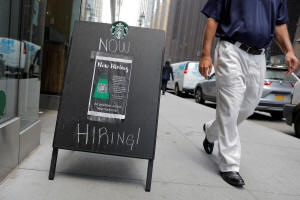US labor market still tight; housing market slump persists
 Send a link to a friend
Send a link to a friend
 [July 21, 2023] By
Lucia Mutikani [July 21, 2023] By
Lucia Mutikani
WASHINGTON (Reuters) - The number of Americans filing new claims for
unemployment benefits unexpectedly fell last week, touching the lowest
level in two months amid ongoing labor market tightness and defying
efforts by the Federal Reserve to slow demand.
The second straight weekly decline in claims reported by the Labor
Department on Thursday raised cautious optimism that the economy could
avoid a dreaded recession this year. It followed recent data showing
inflation subsiding in June. Labor market strength is also supporting
wage growth, helping consumer spending to continue plodding along.
"The warning clouds of recession have scattered and company layoffs have
come back down," said Christopher Rupkey, chief economist at FWDBONDS in
New York. "If there is a recession out there, it is one without too many
job losses. We donít know of any such recessions in economic history so
there must not be one looming."
Initial claims for state unemployment benefits dropped 9,000 to a
seasonally adjusted 228,000 for the week ended July 15, the lowest level
since mid-May. Economists polled by Reuters had forecast 242,000 claims
for the latest week.
Unadjusted claims fell by 326 to 257,976 last week. Claims surged by
5,059 in California and increased by 4,616 in Georgia.

There were also notable rises in filings in South Carolina and Oregon,
which were more than offset by significant declines in Michigan,
Kentucky, Indiana, New York, New Jersey, Iowa and Illinois.
Last week's drop in claims was likely exaggerated by difficulties
adjusting the data for seasonal patterns.
"The seasonal adjustment factor for this week anticipated a modest
increase, reflecting the fact that initial filings tend to rise in the
second full week of July each year," said Lou Crandall, chief economist
at Wrightson ICAP in Brooklyn, New York. "However, that tendency only
applies to weeks ending between July 8 and July 13."
Automakers typically idle plants in July to retool for new models. But
these temporary plant closures do not always happen around the same
time, which could throw off the model that the government uses to strip
out seasonal fluctuations from the data.
Claims, relative to the size of the labor market, are way below the
280,000 level that economists say would signal a significant slowdown in
job growth. The labor market remains tight as companies hoard workers
after struggling to find labor during the COVID-19 pandemic, despite the
economy slowing because of the Fed's hefty interest rate increases.
The U.S. central bank is expected to resume hiking rates next Wednesday
after skipping an increase in June. The Fed has raised its policy rate
by 500 basis points since March 2022, when it kicked off its fastest
monetary policy tightening cycle in more than 40 years.
"Many employers are reluctant to reduce headcount despite a slower
economy, since the labor market is very tight, which might make rehiring
difficult if growth picks up in six or twelve months," said Bill Adams,
chief economist at Comerica Bank in Dallas.
Economists shrugged off a separate report from the Conference Board
showing its Leading Economic Index, a gauge of future U.S. economic
activity, dropped for the 15th straight month in June, the longest such
streak since 2007-08, when the economy was in the midst of the Great
Recession.

[to top of second column] |

A sign advertising job openings is seen
outside of a Starbucks in Manhattan, New York City, New York, U.S.,
May 26, 2021. REUTERS/Andrew Kelly/File Photo

"However, with most of the weakness in a few sentiment-based
indicators, the recession signal is not as strong as it appears,"
said Michael Pearce, lead U.S. economist at Oxford Economics in New
York.
Stocks on Wall Street were mixed. The dollar rose against a basket
of currencies. U.S. Treasury prices fell.
LOW LAYOFFS
The claims data covered the week during which the government
surveyed businesses for the nonfarm payrolls component of July's
employment report. Claims fell during the June and July survey
weeks. The economy added 209,000 jobs in June.
The number of people receiving benefits after an initial week of
aid, a proxy for hiring, increased 33,000 to 1.754 million during
the week ending July 8, the claims report showed.
At current levels, the so-called continuing claims are low by
historical standards, indicating that some laid-off workers are
quickly finding work.
While the labor market remains resilient, housing and manufacturing
continue to struggle. A third report from the National Association
of Realtors showed existing home sales fell 3.3% in June to a
seasonally adjusted annual rate of 4.16 million units, the lowest
level since January.
A perennial shortage of houses on the market and higher mortgage
rates are weighing on sales. With supply tight, house prices are
rising again on a monthly basis. This together with the average rate
on the popular 30-year fixed mortgage just under 7%, according to
data from mortgage finance agency Freddie Mac, could price
first-time buyers out of the market.
Most homeowners have mortgage rates under 5%, meaning they have no
incentive to sell. Last month's sales pace was the weakest for any
June since 2009, during the sub-prime mortgage crisis.
"Perhaps stabilizing prices will be enough to convince more owners
to put their homes on the market, but it's likely that the fate of
both existing home inventories and mortgage rates will remain linked
for the foreseeable future," said Erik Johnson, a senior economist
at BMO Capital Markets in Toronto.

A fourth report from the Philadelphia Fed showed factory activity in
the mid-Atlantic region still subdued in July, but manufacturers
were more upbeat about business conditions over the next six months.
"Softer demand for goods and higher borrowing costs continue to be
hurdles," said Rubeela Farooqi, chief U.S. economist at High
Frequency Economics in New York.
"But re-shoring of supply chains, infrastructure projects and a
stabilization in rates and demand could provide support to
manufacturing activity over time."
(Reporting by Lucia Mutikani; Additional reporting by Safiyah Riddle
in New York; Editing by Paul Simao and Andrea Ricci)
[© 2023 Thomson Reuters. All rights
reserved.]
This material may not be published,
broadcast, rewritten or redistributed.
Thompson Reuters is solely responsible for this content. |